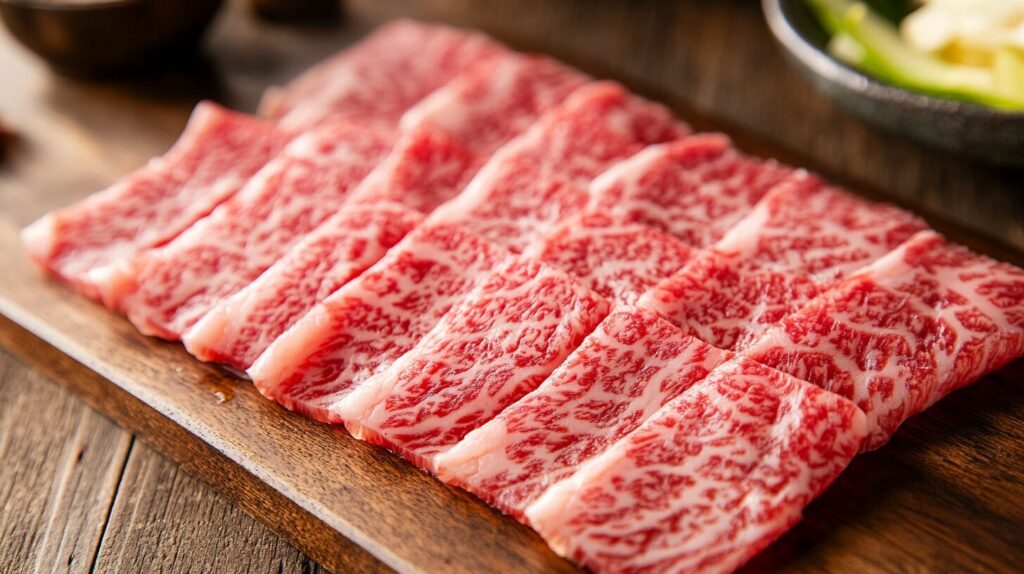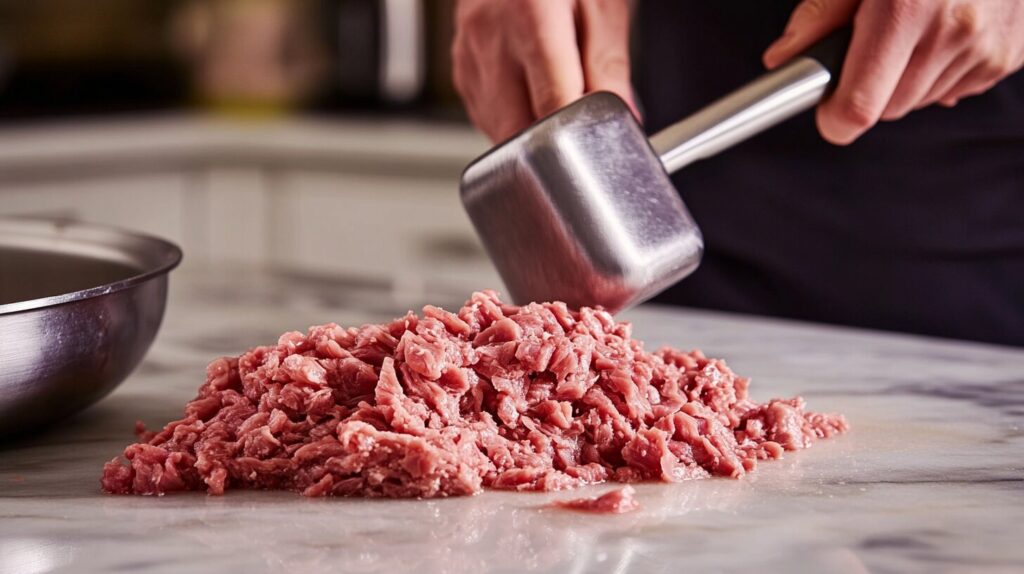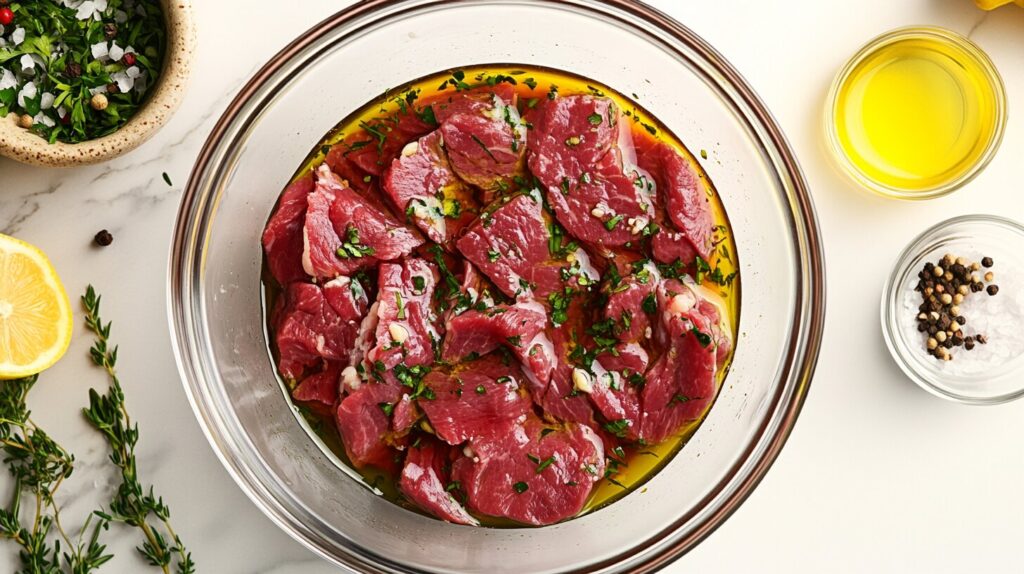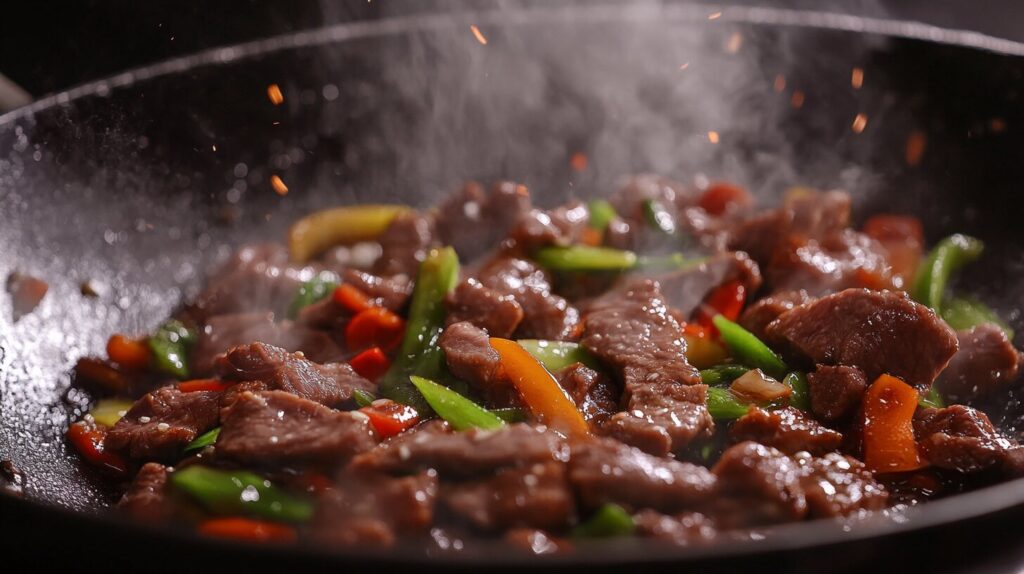
Shaved beef is a versatile ingredient, and knowing how to tenderize shaved beef can enhance its thin slices, whether from ribeye, sirloin, or chuck. These ultra-thin slices are perfect for dishes requiring quick cooking times. Many recipes use shaved beef to take advantage of its tender, flavorful meat and minimal preparation time. It’s commonly used in cheesesteaks, Asian stir-fries, tacos, and hotpot. The thin slicing helps make the meat more tender, but it’s still important to tenderize shaved beef, especially when using tougher cuts. Understanding shaved beef helps you choose the best cuts and techniques for optimal results. For a deeper dive into recipes using this versatile ingredient, check out our Ultimate Guide to Shaved Beef Recipes.
Table of Contents
Characteristics of Shaved Beef
Shaved beef has distinct characteristics that make it suitable for a variety of dishes. These slices typically measure paper-thin, often less than 1/8 inch thick. This thin slicing allows the beef to cook in a matter of minutes, making it ideal for quick meals. Despite its thinness, shaved beef can still come from tougher cuts, which is why tenderizing can improve its texture. When you cut shaved beef from ribeye, it often contains high marbling (fat streaks), which enhances flavor. It is also versatile enough to be cooked in multiple ways, including grilling, stir-frying, or boiling in soups.
Common Uses of Shaved Beef in Cooking
Shaved beef is incredibly versatile and can be used in numerous dishes across various cuisines. It is the star ingredient in classic American cheesesteaks, providing a tender, juicy bite when cooked with onions and cheese. In Asian cuisine, shaved beef is used in stir-fries, hotpot, and bulgogi. Mexican dishes like tacos, fajitas, and quesadillas benefit from the quick-cooking nature of shaved beef. It is also perfect for Italian beef sandwiches and French dip sandwiches. Because it cooks quickly, shaved beef is ideal for busy weeknights or last-minute meals where time is limited.
Why Does Shaved Beef Need Tenderizing?
When you tenderize shaved beef, you ensure a soft, enjoyable texture, especially if the beef comes from tougher cuts. Even though the beef is sliced thin, certain cuts still contain dense muscle fibers and connective tissues that can result in chewiness. When you tenderize shaved beef, you break down these fibers and allow the meat to absorb marinades more effectively. Tenderizing also helps prevent the beef from becoming tough during cooking, especially if it’s exposed to high heat. Whether you’re making stir-fries, cheesesteaks, or tacos, tenderizing helps ensure the beef remains juicy, flavorful, and easy to chew.
The Science Behind Beef Toughness
Beef toughness is primarily due to muscle fibers, connective tissue, and collagen content. The more a muscle is used by the animal, the tougher it will be due to the dense fibers and connective tissues that develop. Chuck or round cuts tend to be naturally tougher than cuts from the rib or loin. When beef is heated, the proteins contract, which can further toughen the meat. Collagen begins to break down when cooked slowly at low temperatures, transforming into gelatin, which makes the meat tender. Tenderizing techniques help break down these components for a more enjoyable texture.
Benefits of Tenderizing Shaved Beef
Tenderizing shaved beef offers several advantages that enhance the overall eating experience. It improves the texture by softening the muscle fibers, making the meat easier to chew and more pleasant to eat. Additionally, tenderizing allows marinades and seasonings to penetrate deeper, enhancing the flavor of the beef. Properly tenderized beef also cooks more evenly and quickly, reducing the risk of overcooking. This is particularly useful for thin slices, which can become tough if not handled correctly. Ultimately, tenderizing ensures that your shaved beef dishes are flavorful, juicy, and consistently tender every time you cook them.
Preparing Shaved Beef for Tenderizing
Proper preparation is essential for successful tenderizing of shaved beef. Start by selecting the right cut of beef, such as ribeye for tenderness, sirloin for a balance of flavor and lean meat, or chuck for budget-friendly options. Once you have the right cut, slicing the beef properly is crucial. Partially freezing the beef for 20-30 minutes helps achieve thin, uniform slices. Use a sharp knife or meat slicer to ensure precision. Always slice against the grain to shorten the muscle fibers, which makes the beef naturally more tender. Proper preparation sets the stage for effective tenderizing techniques. Learn how to Cook Shaved Steak So It’s Not Dry for best results.
Choosing the Right Cut of Beef
Selecting the right cut of beef is key to achieving tender shaved beef. If you’re curious about different beef cuts, explore our Comprehensive Guide to Beef Tips for helpful insights. Ribeye is the top choice due to its marbling, which adds juiciness and flavor. Sirloin offers a leaner option but remains relatively tender when cooked quickly. Chuck is a tougher cut but provides excellent flavor at a lower cost, making it ideal for dishes where tenderizing is applied. Other cuts like brisket or round can also be used if tenderized properly. When choosing beef, look for cuts with visible marbling, as the fat will melt during cooking, enhancing tenderness and flavor.
Properly Slicing Beef for Shaving
Slicing beef correctly is essential for creating shaved beef that cooks evenly and remains tender. To achieve the best results, partially freeze the beef for about 20-30 minutes. This firms up the meat, making it easier to slice thinly. Use a sharp chef’s knife or a meat slicer to cut slices that are around 1/8 inch or thinner. Always slice against the grain, which shortens the muscle fibers and helps make the beef naturally more tender. Uniform slices ensure that the beef cooks evenly and absorbs marinades or seasonings more effectively, enhancing both texture and flavor.
Methods for Tenderizing Shaved Beef
There are several effective methods for tenderizing shaved beef, ranging from mechanical techniques to chemical and thermal processes. Each method works in different ways to break down muscle fibers and connective tissues. Mechanical techniques, like using a meat mallet or scoring, physically alter the beef’s structure. Chemical methods rely on acidic or enzymatic ingredients to break down proteins. Thermal methods use controlled heat to soften the beef through cooking processes. The method you choose depends on the cut of beef and the dish you’re preparing. Combining these methods can also produce excellent results for optimal tenderness.
Mechanical Tenderizing Techniques
Mechanical techniques help you tenderize shaved beef by physically breaking down the fibers to improve its texture. These methods are quick and straightforward, making them ideal for home cooks.
Using a Meat Mallet

A meat mallet is a simple and effective tool for tenderizing shaved beef. Place the beef between two sheets of plastic wrap or parchment paper to protect it. Gently pound the beef with the flat or spiked side of the mallet. Since shaved beef is already thin, use light pressure to avoid tearing the slices. Pounding breaks down muscle fibers, making the meat more tender and receptive to marinades. This method is best for tougher cuts like chuck or round, where physical tenderizing can significantly improve texture.
Scoring the Beef
When you score the beef, you make shallow cuts on its surface in a crosshatch pattern. Use a sharp knife to lightly score the meat, being careful not to cut too deeply. This technique helps break down the muscle fibers and allows marinades or seasonings to penetrate more effectively. Scoring is particularly useful for thin slices of beef that need quick tenderizing. It’s also a great way to improve texture in dishes like stir-fries, where the beef needs to cook quickly and absorb flavor efficiently.
Chemical Tenderizing Techniques
Chemical tenderizing relies on ingredients that break down the proteins in beef. This method is especially useful for tougher cuts and enhances both texture and flavor.
Using Marinades with Acidic Ingredients

Acidic marinades with vinegar, lemon juice, or yogurt can effectively tenderize shaved beef. The acid helps break down the proteins, making the meat softer and more flavorful. To tenderize shaved beef, combine your chosen acid with oil, herbs, and spices. Allow the beef to marinate for 15-30 minutes; any longer can make the thin slices mushy. For example, a simple marinade of lemon juice, olive oil, garlic, and rosemary can add both tenderness and flavor to your dish. Always discard used marinade or boil it before using it as a sauce.
Enzymatic Tenderizers (Papaya and Pineapple)
Papaya and pineapple contain natural enzymes (papain and bromelain) that break down proteins and tenderize meat. To use these tenderizers, blend fresh papaya or pineapple and mix with your marinade ingredients. Apply the marinade to the shaved beef and let it sit for 15-30 minutes. Be cautious with timing, as these enzymes can over-tenderize the beef, turning it mushy if left too long. Enzymatic tenderizers are particularly effective for tougher cuts like chuck or round, enhancing both texture and flavor. Rinse the beef lightly before cooking to remove excess marinade.
Thermal Tenderizing Techniques
Thermal methods use heat to gradually break down muscle fibers and connective tissues, resulting in tender meat. These techniques are ideal for tougher cuts and certain cooking styles.
Slow Cooking Methods
Slow cooking allows shaved beef to become tender by breaking down collagen and connective tissues over time. Cook the beef in a broth, sauce, or marinade at low heat for 1-2 hours. This method works well for dishes like beef tacos, soups, or stews. The beef absorbs the flavors of the cooking liquid while becoming soft and tender. To prevent overcooking, check the beef periodically and adjust the cooking time as needed. Slow cooking is particularly effective for tougher cuts like chuck, turning them into juicy, flavorful meat.
Quick Stir-Frying Tips

Stir-frying is a high-heat, quick-cooking method that helps preserve the tenderness of shaved beef. Heat a wok or skillet until very hot, then add a small amount of oil. Add the beef in batches to avoid overcrowding, and cook for 2-3 minutes, stirring constantly. Overcooking can make the beef tough, so remove it from the heat as soon as it’s browned. Marinating the beef beforehand with soy sauce, garlic, and cornstarch helps tenderize it further and adds flavor. This method is perfect for Asian dishes like beef and broccoli or Mongolian beef.
Best Marinades for Tenderizing Shaved Beef
Marinades not only tenderize shaved beef but also enhance its flavor. The key to a great marinade is balancing acidity, oil, and seasonings. Here are some tried-and-true options.
Classic Acid-Based Marinades
Classic acid-based marinades use ingredients like vinegar, lemon juice, or wine to break down proteins. For example, mix ¼ cup of red wine vinegar, 2 tablespoons of olive oil, minced garlic, and herbs like thyme or rosemary. This combination works well for shaved beef used in cheesesteaks or fajitas. Acid-based marinades should be used for 15-30 minutes to avoid over-tenderizing. Adding a bit of sugar or honey can balance the acidity and add a subtle sweetness.
Enzymatic Marinades: Recipes and Tips
Enzymatic marinades use natural enzymes to tenderize meat. For a pineapple-based marinade, combine ½ cup of fresh pineapple juice, 2 tablespoons of soy sauce, minced garlic, and ginger. For a papaya-based marinade, blend fresh papaya with lime juice and a splash of olive oil. You should apply these marinades for no more than 20-30 minutes to avoid turning the beef mushy. Enzymatic marinades are perfect for tougher cuts and add a tropical flavor profile.
Flavor-Enhancing Seasonings
Adding seasonings to your marinade enhances the overall taste of the shaved beef. Common seasonings include garlic, ginger, soy sauce, Worcestershire sauce, cumin, and chili powder. Fresh herbs like rosemary, thyme, and cilantro add depth. A blend of olive oil, garlic, lemon juice, and cracked black pepper works well for Mediterranean-style dishes. Experiment with different seasoning combinations to match the flavors of your dish, ensuring the beef is both tender and delicious.
Common Mistakes When Tenderizing Shaved Beef
Understanding common mistakes when tenderizing shaved beef can help you achieve the best results. These errors can affect texture, flavor, and overall cooking success. Avoiding them ensures that your shaved beef remains tender, juicy, and flavorful, regardless of the dish.
Over-Tenderizing the Meat
One of the most common mistakes is over-tenderizing the meat. Because shaved beef is already cut very thin, it does not require long tenderizing times. Over-tenderizing, whether by pounding, marinating, or using enzymatic solutions, can break down the beef too much and make it mushy. For acidic or enzymatic marinades, 15-30 minutes is usually sufficient. When using a meat mallet, use gentle pressure to avoid tearing the meat. Always monitor the process closely and remember that less is often more with thin slices of beef.
Choosing the Wrong Tenderizing Method
Selecting the right tenderizing method is crucial for achieving the desired texture. Mechanical methods like pounding or scoring work best for tougher cuts like chuck or round. In contrast, more delicate cuts like ribeye benefit from a light marinade rather than physical tenderizing. Chemical methods, such as acidic or enzymatic marinades, work well for most cuts but need careful timing to avoid over-tenderizing. Matching the right method to the cut of beef ensures the meat’s texture remains optimal. Using the wrong method can result in chewy, tough, or mushy meat.
Skipping the Resting Period
Resting the beef after tenderizing and cooking is often overlooked but is essential for achieving the best results. Resting allows the meat fibers to relax and the juices to redistribute, leading to a more tender and flavorful bite. After marinating or pounding, let the beef rest for 5-10 minutes before cooking. Once cooked, allow the beef to rest for another 5 minutes before serving. Skipping this step can cause the juices to run out, resulting in dry and tough meat. Resting ensures that your shaved beef remains juicy and tender.
Tips for Cooking Tender Shaved Beef
Cooking shaved beef properly is just as important as knowing how to tenderize shaved beef correctly. Because it cooks quickly, using the right techniques ensures the meat remains tender and flavorful. These tips can help you achieve perfect results every time.
Quick High-Heat Cooking Methods
Shaved beef benefits from quick, high-heat cooking methods that sear the meat without overcooking it. Techniques like stir-frying, sautéing, and grilling are ideal. Heat your pan or grill to a high temperature before adding the beef. Cook the meat in small batches to avoid overcrowding, which can cause the beef to steam instead of sear. Each batch should take no more than 2-3 minutes. The high heat locks in moisture and creates a flavorful crust. This method works well for dishes like cheesesteaks, fajitas, and stir-fries.
How to Avoid Overcooking Shaved Beef
Overcooking is a common issue with shaved beef because the slices are so thin. Overcooking can quickly turn tender meat into a tough, dry mess. To avoid this, cook the beef for just a few minutes over high heat. Pay attention to the color and texture, removing the beef from the heat as soon as it is browned. If you’re cooking in batches, keep the cooked beef warm under foil. Avoid leaving the beef on the heat for too long or using low temperatures, as this can cause it to dry out and lose tenderness.
How Do You Tenderize Shaved Beef for Specific Dishes?
Different dishes may require different ways to tenderize shaved beef for the best texture and flavor. Tailoring your tenderizing approach to the dish ensures the beef complements the recipe perfectly.
Tenderizing for Cheesesteaks
For cheesesteaks, ribeye is the preferred cut due to its marbling and tenderness. To prepare the beef, use a light marinade with Worcestershire sauce, garlic, and a splash of soy sauce. If using tougher cuts like chuck, lightly pound the beef with a meat mallet to break down the fibers. Cook the beef quickly over high heat with onions and peppers, then top with melted cheese. This method ensures the beef remains tender and flavorful, providing the classic cheesesteak experience.
Tenderizing for Stir-Fries
Stir-fries require quick-cooking beef with a tender texture. Marinate the shaved beef in a mixture of soy sauce, ginger, garlic, and cornstarch for 15-20 minutes. The cornstarch helps protect the beef during cooking and adds a velvety texture. Avoid mechanical tenderizing for stir-fries, as the thin slices can tear easily. Cook the beef over high heat for 2-3 minutes, stirring constantly. This technique ensures the beef stays tender and juicy while absorbing the flavors of the stir-fry sauce and vegetables.
Tenderizing for Tacos and Fajitas
For tacos and fajitas, shaved beef benefits from a marinade with lime juice, cumin, garlic, and chili powder. The acidity of the lime juice helps break down the muscle fibers, making the beef more tender. Let the beef marinate for 15-30 minutes. If using a tougher cut, lightly score the beef before marinating to help the flavors penetrate. Cook the beef quickly over high heat in a skillet or on a grill. This method keeps the beef juicy and flavorful, making it perfect for filling tortillas with toppings like peppers, onions, and salsa.
Frequently Asked Questions (FAQs)
Can you tenderize beef without a meat mallet?
Yes, you can tenderize beef without a meat mallet by using marinades, scoring the meat, or slicing it thinly against the grain. Acidic or enzymatic marinades can break down the proteins, making the beef more tender. Freezing the beef slightly before slicing also helps achieve thin, tender slices. Scoring the meat with a sharp knife allows marinades to penetrate more effectively, improving tenderness without the need for physical pounding.
How long should you marinate shaved beef?
For shaved beef, marinate for 15-30 minutes. Because the slices are thin, they absorb flavors quickly and tenderize faster than thicker cuts. Marinating for too long, especially with acidic or enzymatic marinades, can over-tenderize the beef and make it mushy. If using a milder marinade with herbs and oil, you can marinate for up to an hour. Always discard the used marinade or boil it before using it as a sauce to ensure safety.
What is the quickest way to tenderize shaved beef?
The quickest way to tenderize shaved beef is to use an acidic marinade with ingredients like vinegar, lemon juice, or soy sauce. A 15-minute soak can significantly improve tenderness. Alternatively, a light sprinkling of baking soda followed by a 15-minute rest can also tenderize the beef quickly. Rinse the baking soda off before cooking. These methods are fast, easy, and effective for improving the texture of shaved beef.
Can you use baking soda to tenderize beef?
Yes, baking soda can be used to tenderize beef. It works by raising the pH on the surface of the meat, which prevents proteins from bonding and makes the meat more tender. To use baking soda, sprinkle a small amount over the beef and let it sit for 15-20 minutes. Rinse thoroughly before cooking to remove any residual baking soda taste. This method is effective for quick tenderizing, especially for stir-fries or grilled dishes.
What is the best cut of beef for shaved steak?
The best cut of beef for shaved steak is ribeye due to its tenderness and marbling. Sirloin is another good option for a leaner choice that still offers a tender texture. Chuck can be used if you’re on a budget, but it benefits from additional tenderizing techniques. For sandwiches, stir-fries, and tacos, ribeye or sirloin are ideal because they cook quickly and remain tender. Choosing the right cut ensures the best results for your dish.
Is there a difference between tenderizing and marinating?
Yes, tenderizing and marinating serve different purposes. Tenderizing focuses on breaking down muscle fibers to improve texture, using mechanical, chemical, or thermal methods. Marinating adds flavor and may include tenderizing ingredients like acids or enzymes. While some marinades also tenderize, not all marinades are designed for this purpose. Understanding the difference helps you choose the right method for your desired result, ensuring both flavor and texture are optimized.
Conclusion: Enjoy Tender and Flavorful Shaved Beef Every Time
Tenderizing shaved beef doesn’t have to be complicated. By Understanding how to tenderize shaved beef using mechanical, chemical, or thermal techniques ensures every dish you prepare is juicy and flavorful. Choosing the right cut of beef, such as ribeye for tenderness or chuck for a budget-friendly option, sets the foundation for success. Pairing the correct tenderizing method with your chosen cut enhances the beef’s texture and taste, allowing you to create dishes that are enjoyable and satisfying.
Marinades with acidic or enzymatic ingredients, like lemon juice or papaya, can quickly tenderize shaved beef by breaking down muscle fibers. Mechanical methods, such as using a meat mallet or scoring the beef, provide quick and effective results, especially for tougher cuts. Slow-cooking methods and high-heat stir-frying help you maintain tenderness during cooking, ensuring that the beef doesn’t become dry or chewy.
Avoiding common mistakes like over-tenderizing, choosing the wrong method, or skipping the resting period helps maintain the integrity of the beef. With the right preparation, cooking techniques, and attention to detail, you can achieve restaurant-quality results at home. Whether you’re making cheesesteaks, stir-fries, tacos, or fajitas, properly tenderized shaved beef elevates the dish to a whole new level.
Incorporate these tips into your cooking routine, and you’ll consistently enjoy tender, flavorful shaved beef that delights your taste buds and impresses your guests. Cooking with confidence and knowledge will make your meals not only easier to prepare but also more enjoyable to eat.
